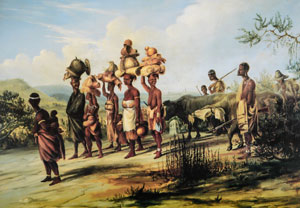Inaugural address Professor Jan-Bart Gewald at Leiden University
 On the occasion of his appointment as a Professor of History of Southern Africa, ASC researcher Jan-Bart Gewald gave his inaugural address 'To Grahamstown and Back: Towards a Socio-Cultural History of Southern Africa' at the Department of Humanities at Leiden University on Friday 6 June.
On the occasion of his appointment as a Professor of History of Southern Africa, ASC researcher Jan-Bart Gewald gave his inaugural address 'To Grahamstown and Back: Towards a Socio-Cultural History of Southern Africa' at the Department of Humanities at Leiden University on Friday 6 June.
Read the full text of the lecture.
Have a look at the pictures of the ceremony.
Abstract:
To Grahamstown and Back: Towards a Socio-Cultural History of Southern Africa
In his lecture Prof. Jan-Bart Gewald describes and expands upon a painting by Thomas Baines that depicts Amaxhosa migrant labourers leaving the Cape Colony in 1848. It is Gewald’s belief that what is depicted in this painting is representative of what happened in Southern Africa as a whole between 1650 and the present. He uses the painting as a lens through which to look and think about the sub-continent’s past and present. He does this by examining the painting in terms of what it tells us about the movement of people, goods and ideas in Southern Africa. In investigating the manner in which people have sought to acquire what they desire, often in the face of constraints - be they environmental, geographical or political - coupled with their ideas with regard to the manner in which the world functions, he seeks to throw light on fundamental processes that determine Southern Africa's human history. What happened in the Eastern Cape was a precursor to events further afield. Focussing on the painting, the body of the lecture is divided into three parts that consider the movement and control of people, goods and ideas in Southern Africa's historical past.
The social and cultural context of goods
Bearing in mind the admonition not to be antiquarian in the pursuit of historical meaning, Gewald seeks to begin with the material objects of everyday life and then place them in a socio-cultural setting and study them through time. In keeping with this approach, he shies away from a belief in the number-crunching capacities of computers for although they may well throw up interesting anomalies with regard to the import of goods, they cannot tell us what the symbolic value and social or cultural context of these goods was, let alone the wide variety of meanings in terms of age, seniority, gender and race that people attached to such goods. The acquisition of material goods transformed the material cultures of the societies involved. Over time there has been a convergence of desires, consumption and the use of material objects within Southern Africa. These material objects only gain meaning when placed within the socio-cultural context in which they are used.
Southern Africa as a single whole
In conclusion Gewald argues that Southern Africa is a single whole, albeit with different accents. What ties Southern Africa together besides culturally informed deep structure is labour, economic institutions and the consumptive practises of its population. The economic institutions established in the past two centuries, be they mining companies, labour recruiting agencies, retail chains or trade and border agreements bind Southern Africa together. With slight regional variations and dependent on their class position, Southern Africans work for money, for the same employers, eat the same foods and aspire to the same material goods. In these terms, there is more that binds Southern Africans together than divides them.
 Prof. Jan-Bart Gewald is a senior researcher at the ASC and Professor of History of Southern Africa at Leiden University.
Prof. Jan-Bart Gewald is a senior researcher at the ASC and Professor of History of Southern Africa at Leiden University.

